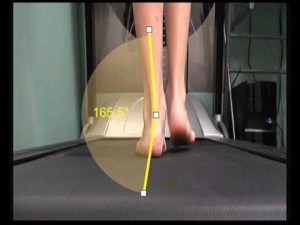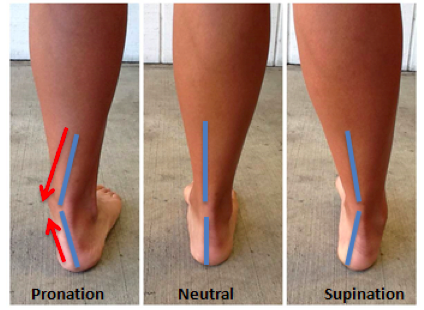 An easy way to deal with any overpronation issues you are having is to pick out the best running shoes for overpronation and wear them every day! This is becoming a real problem in a lot of runners. The fact is, some people just run differently and doing this over time can lead to serious injuries. It is your best bet to deal with them before they come up. The first thing you need to take a look at is how you are running and learn what overpronation actually is.
An easy way to deal with any overpronation issues you are having is to pick out the best running shoes for overpronation and wear them every day! This is becoming a real problem in a lot of runners. The fact is, some people just run differently and doing this over time can lead to serious injuries. It is your best bet to deal with them before they come up. The first thing you need to take a look at is how you are running and learn what overpronation actually is.
Pronation is simply when the weight of your body goes from the heel to the front of your foot and the foot will roll either inwards or outwards when moving. If you are standing up, you can notice pronation if you look down at your feet and notice that the weight of your body is being held up by the inside of your foot. This will cause your arch to be smaller and have flatter feet. This is critical because a good arch in your foot is essential to absorbing shock when you move. There is also something call supination which is the exact opposite. This means that the weight will be transferred to the outside of the foot.
If you have the correct idea of what type of pronation you have, you can then make sure to pick out the best treatment options. If you are a runner with flat feet, there is a high chance that you are over-pronating and that needs to be fixed. If you have a very large arch, runners might see under pronation which can still cause issues in the future.
Here is a list of the best running shoes for overpronation that can help you fix your stance and gate when running.
Best Running Shoes For Overpronation
Overpronation And What It Is
If your foot is rolling either inward or outward when standing or moving, this is over pronation. This causes the weight of your body to be shifted to the inside or outside of foot. If the weight is distributed in such a way, a runner will put unnecessary stress on the ankle joint as well as the lower leg. This can cause issues in stability as well as any type of reaction time. It has also been shown that it can affect your knee and hip joints if gone untreated. You want to ensure that your feet as a runner are efficient and if you are pronating, this is not going to happen. Do not put stress on your body when you do not have to. Below is a picture to show you what it looks like.

How To Tell If You Have It
The first thing you should do is stand about shoulder width apart and look at your feet. Is there a good clear arch in your feet? If you do not see an arch and that part of your foot is touching the ground, you are probably over pronating. The second thing you want to do is take a look at your running shoes and see where their soles are worn down. You can often tell if you are having a pronation issue if the inside of your running sneakers are worn down on the inside only because that is where your weight is transferred during your stride.
Another way you can tell is if you dip your feet in some water and then walk around on a smooth grey surface like the road. You will then want to look at the footprints from the water. If you do NOT have an issue, your footprint will show clearly the heal, an arch area, and then your landing pad with your toes. Over pronaters will be hard pressed to find any difference between the heel and the middle of the foot (meaning flat feet is happening).
Of course, none of these methods are an exact science. If you want to make sure you have a problem, get to the doctor. I recommend you check out a podiatrist as they are trained in this area of expertise. Sometimes if you are experiencing issues they will have you run or jog on things called force plates. These will show the podiatrist where the force of your stride is and where the weight is being distributed. They will asses your running and be able to tell you exactly what is occurring.
How To Correct Over Pronation
After you have gotten checked out, you will either have one of three things. You will stand neutral, your gait will be over supinated, or you will be overpronated.
Since you have that figured out, you will most likely hear that over pronators react very well to picking out a good running shoe. There are a ton of them being sold out there right now, and it can be hard to find a running shoe that is targeted to your specific problem. Below I am going to go over on what you should be looking for when shopping around.
What To Look For In The Best Running Shoes For Over Pronation
Over pronation means that your shoes are more than likely worn on the inside of the foot because of the roll that is occurring during your stride.
Believe it or not, a LOT of runners have this condition. It really does need to be treated as running this way for too long will eventually lead to some sort of injury, knee pain, hip pain, or leg and ankle pain. This can be debilitating and put you off running for months if not taken care of. The best way to deal with it is to get shoes for maximum stability and help control the motion of your gait.
So what are stability shoes you may ask? Well, if you as a runner have arches that are medium height, or just normal and have slight over pronation, you will be able to get some support from these shoes as well as cushioning around the middle of your foot. Over pronation typically affects the arch side of your step so a shoe that provides stability will often give you a firm side of the shoe to help strengthen this area. This is actually a problem with the majority of runners so stability shoes are always a good choice for those looking to get into the sport.
Motion Control Running Shoes
Motion control shoes are a little bit different. These are for runners who have very flat feet or just a little bit of arch which is causing over pronation. These shoes will give you heels that are a lot more stiff than other products. This will help them last longer, and keep your pronation in check. They will also have a wider sole to try and get your foot to land properly. These are mostly recommended to runners who are carrying a little bit of extra weight because they will provide you the support you need but also hold up very well to the strain. Motion control shoes should be looked at for most runners.
Things To Look For In Your Running Shoe
You want to make sure that your shoe is strong! Look for an overlay that is made out of thermoplastic urethane. These usually go over the arch and the heel and will keep the shoe sturdy when running.
Take a look at the midsoles and ensure that the shoes have a very firm and strong post. You want this area to be harder than the rest so it does not break down when running or jogging around. These are often a feature of stability shoes and will help over pronation as well as make the shoe a lot more durable when wearing it. You can get more arch support while wearing these midsoles so make sure you get them.
Always check the outsole as well. You want the heel area to give you motion control by giving extra cushioning to make you feel comfortable but also give support. This is crucial in patients who have over pronation and are having Achilles pain.
Finally, you want the fit of the running show to be spot on. This means that when searching for a runners shoe, you want the material on the inside to actually be hard (can be made of foam or other materials). This will ensure that when you land on it, it will compress, not letting you get hurt and taking some stress away. Having a hard inside of the shoe can also prevent it from compressing too much and flattening your feet.
I hope this guide helps you pick out the best running shoes for overpronation. If you do not want to get running shoes, you could always check out some orthotic insoles but shoes for running are going to be the best treatment option available to you.










Leave a Reply